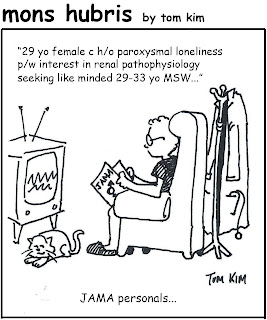Law and Medicine Rounds
 By Dainius A. Drukteinis, M.D., J.D.
By Dainius A. Drukteinis, M.D., J.D.
“The only real mistake is the one from which we learn nothing.”
- John Powell
EMTALA
What is the
"Appropriate Medical Screening Examination"
What is the
"Appropriate Medical Screening Examination"
Chances are if you are an emergency medicine physician or nurse you have probably heard of the acronym EMTALA. Even without knowing what it stands for, you likely shudder at the mere mention of the word, with its authoritative ring as if bellowed from a voice up above . . . E-M-T-A-L-A. If a senior physician tells you, “That violates EMTALA,” you don’t ask questions. You simply look down and respond “Yes, Sensai, it will not happen again.” If you have been in the emergency medicine field a few years, you probably know that EMTALA prohibits a hospital from turning patients away from the Emergency Department, and it also prohibits transferring unstable patients to another facility. You know that a violation of EMTALA means bad things will happen. What those bad things are, however, you are not sure. This is usually the extent of people’s knowledge because to know more would require reading the EMTALA statute, both boring and confusing, or court case opinions, more boring and more confusing.
This article introduces the basic concepts of EMTALA by providing a brief history of the statute with its original purpose, a discussion of the statute’s actual form, and subsequent interpretations of EMTALA based on cases. It is written in non-legal fashion, with details in the endnotes for those of you for whom “seeing is believing.” It then challenges your understanding of EMTALA by having you work through a real case before being given the Court’s rationale for its opinion. It will hopefully answer basic questions you have regarding the application of EMTALA, specifically the requirement to perform an “appropriate medical screening examination.” It does not discuss details regarding transferring unstable patients. Do not read this article if you think it will give you EMTALA peace. It will only lead to more questions, as any discussion of legal principles invariably leads to more questions than answers. For the obsessive-compulsive, welcome to the EMTALA black hole.
In the mid-80s, Congress became concerned with reports of emergency rooms refusing medical care to patients without insurance. Hospitals were turning patients away, and transferring unstable patients to other facilities, due to lack of insurance. The practice of refusing to administer medical care or transferring an unstable patient without insurance became referred to as “patient dumping. ” In response to these concerns, Congress enacted the Emergency Medical Treatment and Active Labor Act of 1986 (EMTALA). EMTALA imposes penalties on Medicare and Medicaid participating hospitals for: 1) failure to afford appropriate medical screening to any person who comes to its emergency room, or 2) if an emergency medical condition exists, the hospital fails to render the services necessary to stabilize the patient’s condition.
The keen eye will notice that the statute is not limited to protecting patients without insurance, despite its original intent. It states that an “appropriate medical screening” is required for “any individual [who] comes to the emergency department. ” As discussed above, and recognized by the Circuit Courts, EMTALA was initially enacted to prevent emergency departments from “refusing to accept or treat patients with emergency conditions if the patient does not have medical insurance. ” Perhaps Congress meant for the statute to only include patients without insurance, even though the statute was not written to that effect?
As EMTALA cases arose, hospital attorneys jumped on the above argument, claiming that a patient must demonstrate an “improper motive,” such as lack of insurance; indeed the initial impetus of EMTALA. This strategy, however, was almost universally rejected. Courts decided that despite the initial intent of EMTALA, the final statute does not state that an “improper motive” is required, and its protections are not limited to people without insurance. Not only does the statute specifically protect “any individual,” but also, if an “improper motive” was required, “proving the inner thoughts and prejudices of the attending medical staff” would be “virtually impossible. ” As it was drafted, “EMTALA was enacted to fill a lacuna in traditional state tort law by imposing on hospitals a legal duty (that the common law did not recognize) to provide emergency care to all. ” “[EMTALA’s] core purpose is to get patients into the system who might otherwise go untreated and be left without a remedy because traditional medical malpractice law affords no claim for failure to treat. "
The next hurdle that Courts faced was the definition of an “appropriate medical screening examination.” How would a patient show that a physician did not perform an “appropriate medical screening examination? If it was simply demonstrating that the doctor made an incorrect diagnosis, then federal EMTALA claims would appear very much like state medical malpractice claims, traditionally governed by state law. Was EMTALA giving patients two
 cracks at the same case, one in federal court under EMTALA and one in state court under malpractice principles? The Circuit Courts did not believe that it was the intention of Congress to “substitute state-law malpractice actions” or “duplicate preexisting legal protections. ” The Eighth Circuit Court explained: “Something more than, or different from, ordinary negligence in the emergency-room screening process must be shown to make out a federal claim under EMTALA. ” The Courts eventually came to the conclusion that to prevail on an EMTALA claim, the patient must demonstrate that there was some form of “disparate treatment,” or that the patient was not treated “uniformly” as other patients in the Emergency Department, not simply that there was a missed diagnosis. One Circuit Court defined an “appropriate medical screening examination” as an exam “reasonably calculated to identify critical medical conditions that may be afflicting symptomatic patients and provide that level of screening uniformly to all those who present substantially similar complaints. ”
cracks at the same case, one in federal court under EMTALA and one in state court under malpractice principles? The Circuit Courts did not believe that it was the intention of Congress to “substitute state-law malpractice actions” or “duplicate preexisting legal protections. ” The Eighth Circuit Court explained: “Something more than, or different from, ordinary negligence in the emergency-room screening process must be shown to make out a federal claim under EMTALA. ” The Courts eventually came to the conclusion that to prevail on an EMTALA claim, the patient must demonstrate that there was some form of “disparate treatment,” or that the patient was not treated “uniformly” as other patients in the Emergency Department, not simply that there was a missed diagnosis. One Circuit Court defined an “appropriate medical screening examination” as an exam “reasonably calculated to identify critical medical conditions that may be afflicting symptomatic patients and provide that level of screening uniformly to all those who present substantially similar complaints. ”Did those definitions for an “appropriate medical screening examination” really distinguish EMTALA from malpractice claims? If a physician is careless with one patient, and is not careless with the rest, could it be both malpractice and an EMTALA violation? The answer is yes, there may be an overlap. The failure to perform an “appropriate medical screening examination” may be tantamount to malpractice, but not every malpractice claim is an EMTALA claim. One Court explained:
Consider a situation in which a hospital adheres to a standard requiring tests A, B, and C as part of an appropriate emergency room medical screening. In many instances, this standard will also be the malpractice standard of care. Thus, failure to perform test C, for example would violate both EMTALA and the standard of care applicable in a malpractice claim. But if tests A, B, and C are performed and the doctor evaluating the results draws an incorrect conclusion, a violation of EMTALA may not be established, but medical negligence may be.
In essence, EMTALA only requires that the appropriate tests are ordered and the appropriate history and examination performed. It does not require a correct conclusion from the results and examination performed.
In March 2008, the Department of Health and Human Services, Centers for Medicare and Medicaid Services, established guidelines for EMTALA. The guidelines incorporated the very ideas of uniformity among patients and the prevention of disparate treatment previously described by the Courts. The guidelines state that the screening exam “must be the same [exam] that the hospital would perform on any individual coming to the hospital’s dedicated emergency department with those signs and symptoms” and it must be “reasonably calculated to determine whether an Emergency Medical Condition exists. ”
So what are the repercussions for violating EMTALA? For a statute with so much attention, there must be dire consequences. To enforce the provisions, Congress predicated a hospital’s Medicare reimbursement on compliance with EMTALA. The loss of Medicare funding would pose an enormous financial burden on a hospital for an EMTALA violation. EMTALA also includes a $50,000.00 fine against a hospital and $50,000.00 fine against a treating physician for each EMTALA violation committed. In addition, EMTALA requires the hospital to compensate the patient and family for damages incurred. Individual physicians, on the other hand, while they may be fined, are not individually responsible for compensating a patient or family for damages under EMTALA. Of course, individual physicians may be liable for a patient’s damages based on malpractice principles.
Now consider a case based on the principles outlined above. This case was decided by the Fourth Circuit in Power v. Arlington Hospital Association, 42 F.3d 851 (4th Cir. 1994). Keep in mind that this case was decided prior to the promulgation of the 2008 Interpretive Guidelines of EMTALA cited above. Nevertheless, the new guidelines do not seem to contradict the reasoning of the Fourth Circuit here.
As per the Court, at 5:45 a.m. a 33-year-old unemployed and uninsured female from Great Britain was brought to an Emergency Department by her fiancé. Her lack of health insurance and unemployment were indicated on the front of the chart. She was complaining of pain in her left hip, left abdomen, and in her back running down her left leg. She stated that she was unable to walk, was shaking, and had severe chills. The patient also had a sizeable boil on her left face that was not seen by the medical staff, nor was it mentioned in the medical chart.
A nurse took a history, performed a nursing assessment, and also collected urine for a “dipstick” urinalysis. The Court’s opinion did not elaborate on the nursing assessment. A doctor then examined the patient. He spoke with the patient, ranged her hip, performed a motor exam, and also a leg extension test. In the chart, the exam of her hip was described as normal. The physician also ordered x-rays. Details regarding the rest of the physician’s physical findings were not provided in the Court’s opinion. A second nurse then completed the patient information data and took vital signs, including blood pressure. All of the vital signs were normal at that time.
According to the Court, at the change of shift at 7 a.m. a second doctor examined the patient. He did not review the patient intake information in the chart. He did note that the patient was complaining of left hip pain of unknown etiology. He performed a neurological examination, and concluded that her pain was localized to the left hip and was musculoskeletal in nature. He believed that the patient looked uncomfortable, but not toxic. He did not believe she was ill, and he did not believe that she had an infection. Nevertheless, he ordered an official urinalysis without any other blood work or diagnostic procedures.
The second physician discharged the patient before the results of the urinalysis. He prescribed her anti-inflammatory pain medication, and instructed the patient to return if her pain became worse. He failed to record the results of the x-ray on the chart. The results of the x-rays were also absent from the Court’s opinion. Later, after the patient was discharged, the physician followed up the results of the official urinalysis. It showed the possibility of a mild infection. The doctor then sent a urine culture from the same sample to verify the result.
By the time the urine culture results were ready the next day, the patient had already returned to the emergency department. The patient was in severe septic shock. She required vasopressors for her low blood pressure, and antibiotics. She was eventually admitted to the Intensive Care Unit where she remained for four months. She was on life support equipment. She had both legs amputated below the knees due to loss of circulation secondary to sepsis. She also lost sight in one eye, and developed severe and permanent lung damage. She was eventually transferred to a hospital in her hometown in England.
An orthopedic surgeon testified at trial that the patient’s hip was not the problem. An infectious disease specialist concluded that the patient had a blood infection secondary to lancing the boil on her face 10 days prior to her initial visit. A qualified emergency medicine expert and an infectious disease expert testified that appropriate blood tests would have most likely revealed a blood infection.
Consider the following:
1) Is lack of insurance necessary for an EMTALA violation?
2) Did the medical staff violate EMTALA by not performing an “appropriate medical screening examination?”
3) Are the physicians responsible for the patient’s damages under EMTALA?
4) Is the hospital responsible for the patient’s damages under EMTALA?
5) What are the other potential consequences to the hospital for violating EMTALA?
6) Did the physicians commit medical malpractice?
7) If so, are the physicians responsible for damages to the patient based on medical malpractice principles?
8) Can a physician violate EMTALA and commit medical malpractice?
1) Is lack of insurance necessary for an EMTALA violation?
No. The Fourth Circuit stated, “there is nothing in the statute itself that requires proof of indigence, inability to pay, or any other improper motive on the part of a hospital as a prerequisite to recovery. ” The statute protects “any individual” who seeks emergency medical care.
2) Did the medical staff violate EMTALA by not performing an “appropriate medical screening examination?”
Yes. The jury at trial found that Arlington hospital violated EMTALA. The Fourth Circuit was unwilling to reverse this finding. The Court stated that a jury could have reasonably concluded “a blood test was a necessary component of an appropriate medical screening examination at Arlington Hospital, for a patient who presented at the emergency room with the patient’s symptoms.”
3) Are the physicians responsible for the patient’s damages under EMTALA?
No. EMTALA does not hold physicians responsible for patient damages under EMTALA. A physician may be fined up to $50,000 for an EMTALA violation, but the physician can not be sued by the patient for damages. Here, the trial court dismissed the physicians from the EMTALA case.
4) Is the hospital responsible for the patient’s damages under EMTALA?
Yes. A hospital is responsible for compensating a patient and family for damages under EMTALA. In this case, the jury returned a verdict of $5 million for the patient against Arlington Hospital. This amount, however, was eventually reduced because of the State of Virginia’s caps on damages in medical malpractice-related cases.
5) What are the other potential consequences to the hospital for violating EMTALA?
The hospital could lose its Medicare funding for violating EMTALA, which would pose an enormous financial burden. The hospital may also be fined $50,000.00 for every EMTALA violation. These penalties were not discussed in the civil action above.
6) Did the physicians commit medical malpractice?
Although not specifically decided by the Court, the answer is most likely yes. The physicians here failed to perform an “appropriate medical screening examination” and a patient was harmed as a result. The physicians are most likely liable under medical malpractice principles.
7) If so, are the physicians responsible for the damages to the patient based on medical malpractice principles?
Yes. Under medical malpractice principles, a physician is liable for damages to a patient as a result of the physician’s negligence.
8) Can the physician both violate EMTALA and commit medical malpractice?
Yes. EMTALA violations and medical malpractice principles can overlap. If a physician carelessly fails to perform an “appropriate medical examination,” the Court can also find that the physician committed medical malpractice
Please click here for the REFERENCES used for this article.
Dainius A. Drukteinis, M.D., J.D. is an Attending Physician at MetroHealth Medical Center in Framingham, MA and author of Law and Medicine Rounds. He may be contacted at ddrukteinis@gmail.com











No comments:
Post a Comment